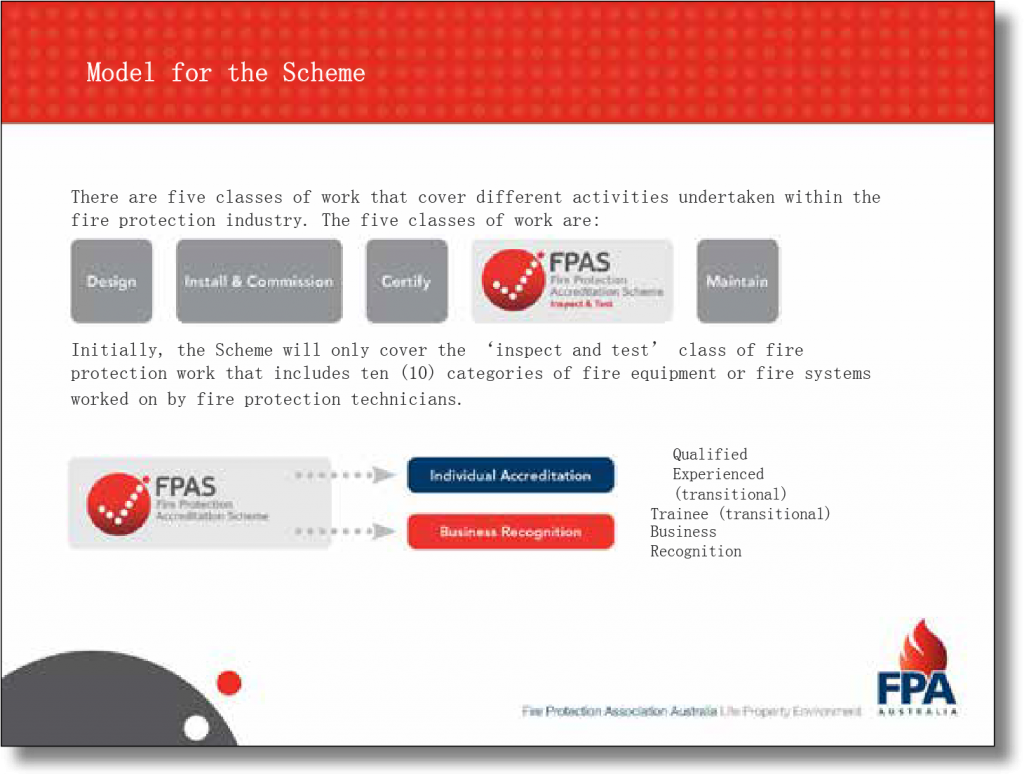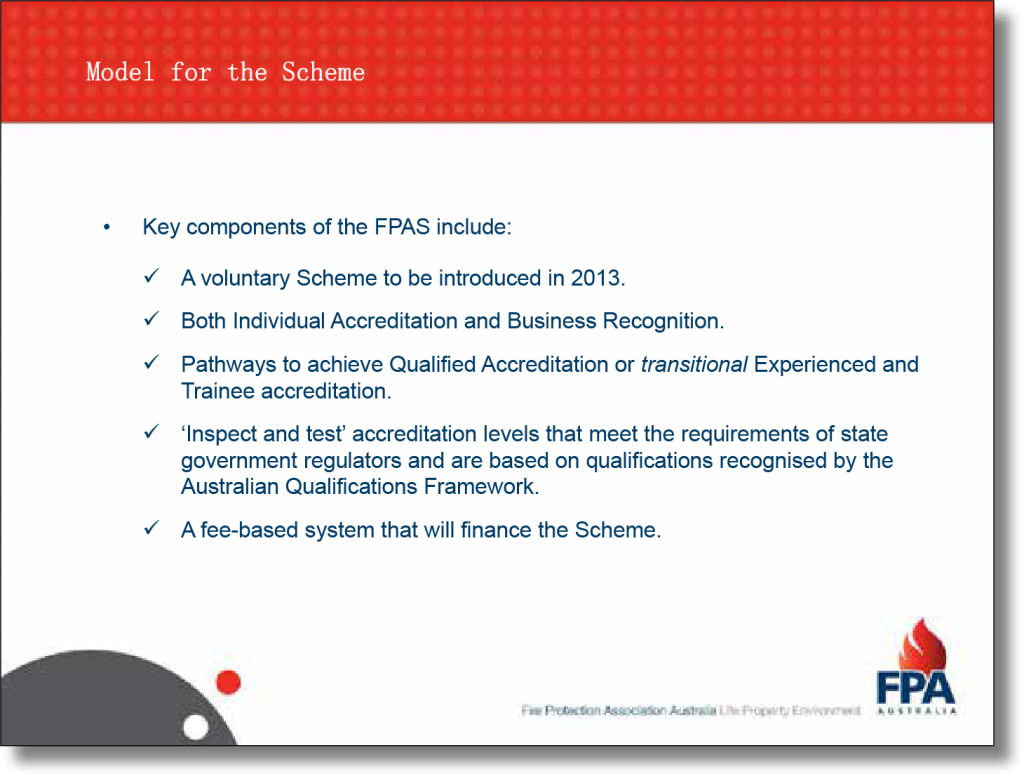by FPAA / Scott William / Rob Llewellyn
The Fire Protection Accreditation Scheme (FPAS) is a voluntary accreditation scheme for the fire protection industry in Australia. It was launched on 1st July 2013 by Fire Protection Association Australia (FPA Australia). It is a formalised process to recognise the appropriate levels of skills and knowledge of fire protection industry practitioners.
The fire protection industry involves many individual occupations linked by one common objective— installing and maintaining equipment and systems to protect life, property and the environment.
However most states and territories in Australia do not have licensing requirements for fire protection industry occupations.
The fire protection industry has, in recent years, been in the spotlight as a result of devastating fire incidents such as the Quakers Hill Nursing Home Fire in NSW, Black Saturday Fires in Victoria, the Childers Backpacker Fire in Queensland and the recent tragic unit fire in Bankstown, Sydney, among others. Despite many jurisdictions referencing the need for ‘competent persons’ in regulation, these events have highlighted varying levels of competency among fire protection industry individuals as well as inadequate supervision, training shortfalls and the need for skills-based accreditation of the fire protection industry workforce. FPA Australia believes there is strong support for ‘tightening up’ the fire protection industry through licensing and accreditation. The desire for increased rigour in this industry led to discussions about the need to plan to develop a national accreditation scheme that is user friendly, transparent and consistent across all state and territories.
The lack of barriers to enter and work in the industry means that, in most states and territories, any individual can undertake fire protection work from design through to ongoing maintenance on fire protection systems and equipment without any experience or education. This situation has contributed to a dangerous level of non- compliance. Leading field-data management company Verified has identified that, of 40,000 buildings surveyed, less than 40 percent achieved compliance to fire protection maintenance standard Australian Standard AS 1851.
This non-compliance relates to life saving measures including fire sprinklers, alarm systems, portable fire extinguishers and fire hydrants. The growing calls to rectify the situation have been underscored by a number of high profile fires around Australia as previously mentioned.
It was with these considerations in mind that in 2012, the FPA Australia Board agreed to initiate work on the development of a suitable framework for accrediting individuals in the fire protection industry nationally, through a voluntary accreditation scheme. The scheme aims to attract industry participants who wish to be independently recognised and promoted as holding the minimum skills, competencies and business requirements to undertake certain activities in the marketplace. The national focus of the Scheme is to ensure uniformity for fire protection practitioners throughout Australia.
FPAS Model
The model for the Fire Protection Accreditation Scheme (FPAS) was launched with the ‘Inspect and Test’ class of fire protection work and is based on the Fire Protection inspection and testing qualifications described in the Australia’s nationally recognised training scheme.
The five classes of work that cover different activities undertaken within the fire protection industry are:
Design
Install & Commission
Certify
Inspect & Test
Maintain
The Scheme consists of:
Individual Accreditation
Business Recognition
Pathways into the Scheme for individual accreditation
There are three (3) pathways into the Scheme for individuals in the ‘inspect and test’ class of accreditation:
Qualified
Experienced (transitional)
Trainee (transitional)
There are ten (10) categories of work activities in the ‘inspect and test’ class as listed below. An individual can be accredited in more than one (1) category.
Fire sprinkler systems
Fire pumpsets
Fire hydrant systems
Fire detection and alarm systems
Gaseous fire suppression systems
Pre-engineered fire suppression systems (non-gaseous)
Portable fire equipment and fire hose reels
Fire and smoke doors
Fire seals and collars
Exitandemergencylighting
Business Recognition is awarded to businesses that invest in the skills, knowledge and experience of their workforce thereby supporting individuals in achieving accreditation. Business entities that are awarded business recognition are bound by a professional code of practice. Business entities that meet business recognition criteria are acknowledged by FPA Australia as:
- being capable of delivering quality professional services by the accredited individuals they engage.
- supporting the industry ‘pathway’ to increasedquality of work and professionalism by ensuring its workforce participates in the Scheme.
The Next Stage of FPAS
FPA Australia is currently working on the next stage of FPAS where a Stakeholder Group is developing the framework for the Design and Certify Classes. FPA Australia is targeting the launch of this next stage to be in November 2014.
Transportation to Other Countries
The FPAS scheme could be easily adapted for application in other countries like Malaysia and FPA Australia would be pleased to make available more information on the scheme.


